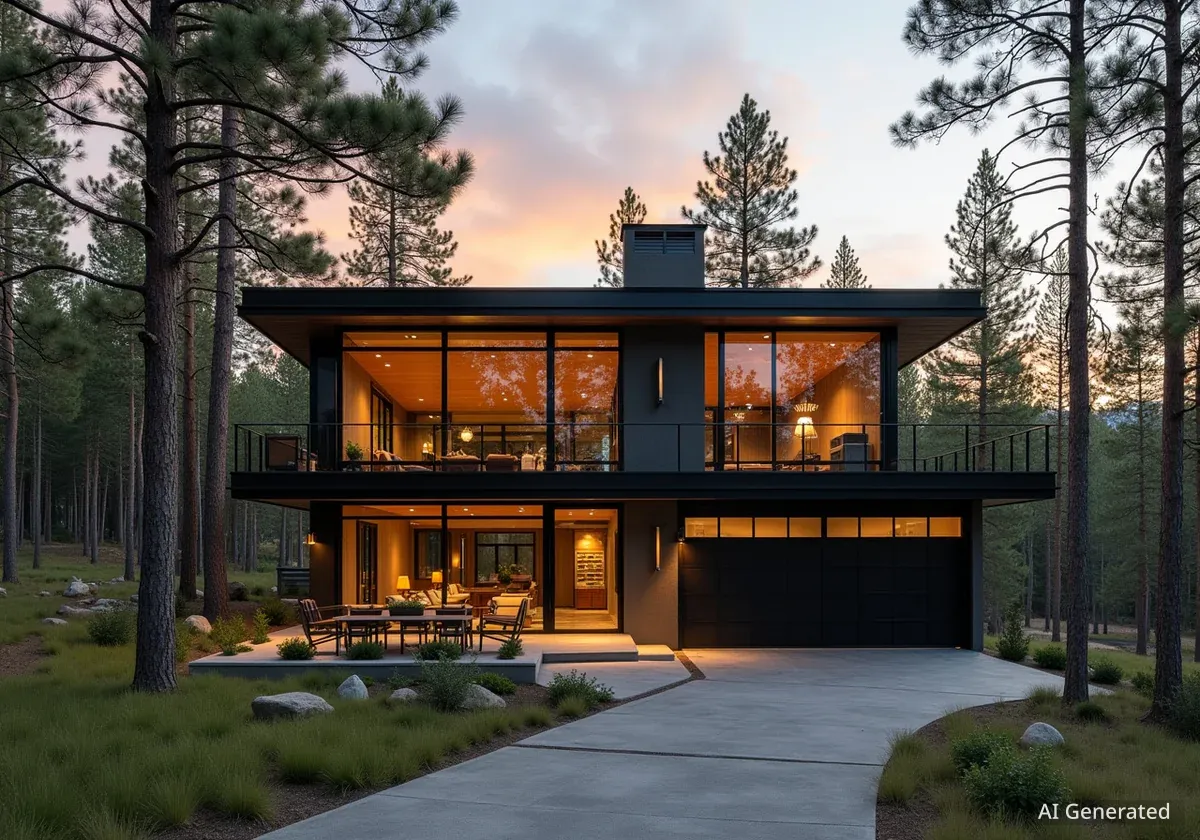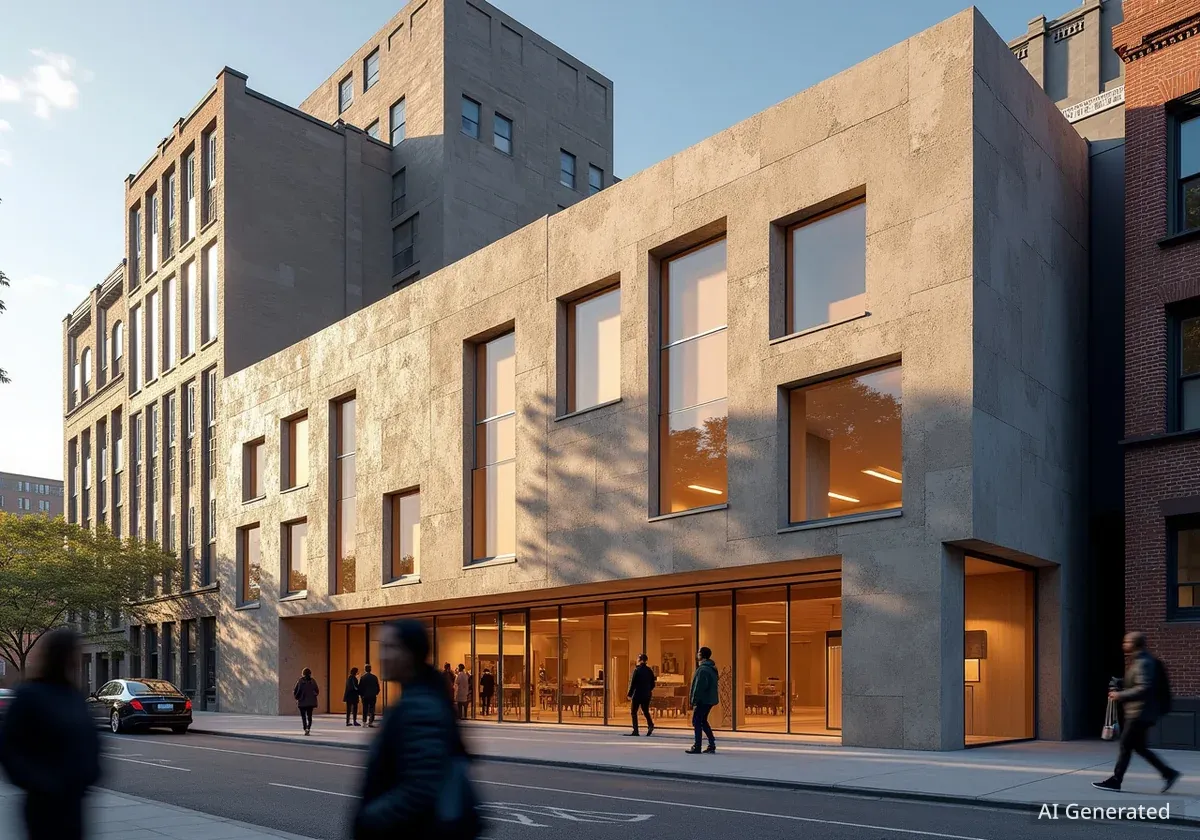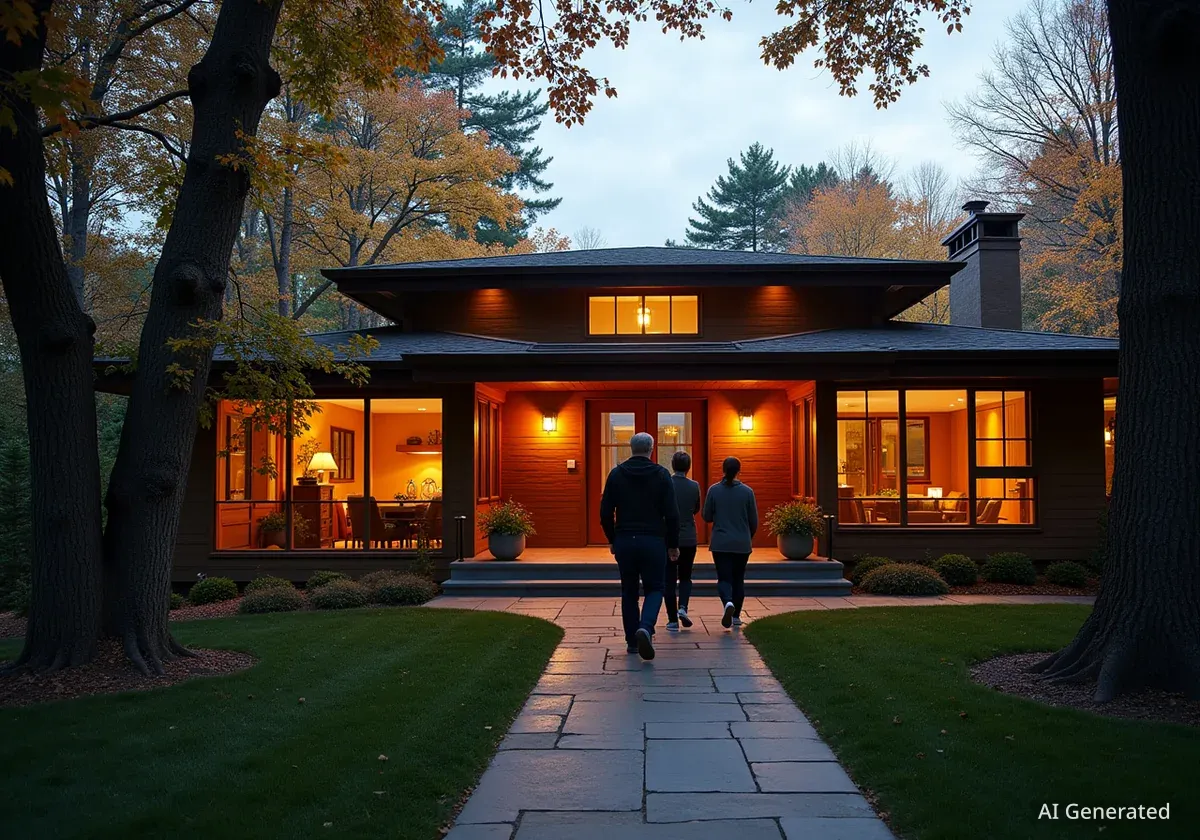A custom-built modern residence, designed by Seattle-based Olson Kundig Architects, now stands in a forested area of Aspen, Colorado. This 15,000-square-foot home represents a shift towards contemporary design for its Los Angeles-based owners, who worked with interior designer Kerry Joyce over 25 years. The project aimed to integrate industrial aesthetics with natural surroundings while ensuring a cozy, comfortable living space for family and friends.
Key Takeaways
- The home is a 15,000-square-foot custom build in Aspen, Colorado.
- Olson Kundig Architects designed the structure with an industrial modern aesthetic.
- Interior designer Kerry Joyce focused on warmth and comfort using natural materials.
- The design prioritizes connection to the natural landscape and accommodates a significant art collection.
- Flexibility and gathering spaces were central to the client's vision for the home.
A Long-Standing Client Relationship Evolves
Interior designer Kerry Joyce has collaborated with the homeowners on four previous house projects over 25 years. This extensive history allowed Joyce to understand their evolving style. Initially, their preferences leaned towards traditional designs. Over time, their aesthetic transitioned to a more transitional look. The Aspen home marks a decisive move into a modern style, which aligns with the architects' vision and Joyce's own modernist inclinations.
Joyce emphasized the deep trust built over decades. He noted that his clients are busy people who rely on his judgment. This trust allowed him to guide the interior scheme in a new direction. Even when proposing slightly different approaches, the clients supported his decisions, confident in a successful outcome.
Design Partnership
- 25 Years: Duration of the client-designer relationship with Kerry Joyce.
- 5 Houses: Number of projects completed together, including the Aspen residence.
- Style Evolution: From traditional to transitional, now distinctly modern.
Designing for Aspen's Natural Landscape
The new residence is a custom build by Olson Kundig, a Seattle-based architecture firm. It is situated on a heavily forested plot in Aspen. The architects aimed for a modern structure that complements its natural setting. Tom Kundig, an owner and principal at Olson Kundig, described the site as remarkably rural and quiet, despite its proximity to downtown Aspen. This location provided a sense of refuge.
The 15,000-square-foot home features an industrial design. It incorporates a palette of dark steel and board-form concrete. Large windows are a key element, establishing a strong visual connection to the surrounding landscape. The chosen colors, primarily browns and grays, blend with the green acres of the forest, integrating the structure thoughtfully into its environment.
"At first impression, I was amazed at how rural and quiet the site felt, especially considering its proximity to downtown Aspen," said Tom Kundig. "Here, at the end of the road on the river, it almost felt like stepping back in time, or stepping into another world. You’re elevated away from the noise, and from the activity, so it creates this sense of refuge."
Integrating Indoors and Outdoors
The design emphasizes the connection to nature. Extensive windows along the western side of the house offer views of a nearby river. This architectural choice ensures that the natural beauty of Aspen is visible from almost every room. The homeowners selected this site specifically for its landscape, valuing the connection to the outdoors as a significant part of their family life and social gatherings.
Kerry Joyce's interior design choices also reflect this connection. Many furnishings are custom-made, with colors and textures that recall the forest and autumnal hues. He believes in honoring the garden view, or the view of nature, as it makes the house "sing."
Aspen's Vibe
Aspen is known for its natural beauty and outdoor activities. The design team sought to capture this essence without resorting to stereotypical mountain lodge aesthetics. The goal was to create an environment that felt compatible with Aspen's vibe, offering both modern luxury and a deep connection to the natural world.
Creating a Hub for Family and Friends
Flexibility was a crucial requirement for the homeowners, who planned to spend extended periods at the property. The primary goal was to create a space for gathering. The clients are very social and enjoy hosting dinners, parties, and weekend trips for family and friends. The home is designed to facilitate human connection.
The entry sequence begins with an expansive garden-lined auto court. Guests are welcomed under a thin steel canopy and through the front door into a gallery-like foyer. A bespoke chandelier by Andreea Braescu adds an organic touch to the linear architecture. The layout strategically places the primary suite on the northern side, with the kitchen and other living spaces at the opposite end.
Thoughtful Layout and Amenities
- Upstairs: Includes a playroom, an office, guest suites, and a bunk room. This provides ample space for grandchildren to spread out and play.
- Ground Level: A glassed-in walkway connects the main house to a guest wing. This wing features two suites and a shared sitting room.
- Kitchen Area: A large window in the main kitchen opens upward with a crank. Adjacent to this, a breakfast room includes a custom-designed table and pendant light.
Even the basement level features thoughtful design. Back-of-house amenities include a catering kitchen and a custom steel and glass wine rack. This wine rack serves as a statement piece, complementing the clients' modern art collection.
Interiors: Warmth, Texture, and Art Integration
To bring warmth to the modern architecture, Joyce selected furnishings made from oiled walnut and cerused oak. Upholstery choices included autumnal-hued leather and mohair. Deep-pile cashmere and mohair rugs provide a luxurious softness underfoot. The furniture style is described as classic modern with Brazilian influences, sometimes verging on brutalist.
Ensuring maximum usability, all upholstered pieces underwent a special sit-testing process. Joyce and his team built prototypes to confirm comfort and correct pitch. This attention to detail highlights the commitment to both aesthetics and functionality. The combination of earthy tones and textured materials adds a refined layer to the rooms.
Material Choices
- Wood: Oiled walnut, cerused oak.
- Fabrics: Leather, mohair, cashmere.
- Flooring: Wide-plank oak, ground and polished concrete.
- Details: Bronze accents, including nightstands and burnished log casts.
Two types of flooring, wide-plank oak and ground and polished concrete, anchor different spaces. Joyce expressed his fondness for patina, applying it to many custom items to achieve a timeless look. Bronze details appear throughout the home, such as nightstands in the primary bedroom and burnished logs cast from real wood in the living room. These elements add artful moments that align with the family's sophisticated style.
Art and Architecture in Harmony
Both Tom Kundig and Kerry Joyce emphasized the clients' modern art collection. Its placement significantly influenced design decisions. Art is a central part of the homeowners' lives; they not only collect it but live with it daily, experiencing it with curiosity. Kundig noted that the house is as much an art house as it is a family house.
The challenge was balancing the art with the powerful landscape. The artworks needed to possess their own strength, either serving as the endpoint of an axial view or becoming part of the larger landscape experience. An example is a sculpture positioned at one end of the pool. This white angular piece is visible from the kitchen, where a kinetic window retracts upward. It contrasts with the forest and pairs with white upholstery on patio lounge chairs.
Contemporary works are displayed in hallways and bedrooms, creating unexpected colorful encounters throughout the house. Designers carefully considered how volumes open up and how circulation paths lead to specific moments. They also identified places of refuge that could become homes for art.
"Art is a big part of their lives—not just collecting it, but really living with it, being curious about it, experiencing it every day," Kundig stated. "From the very beginning, this was an art house as much as it was a family house."
Ultimately, the house is more than just a place to hang paintings or arrange furniture. It functions as a central gathering hub and a retreat. Both Joyce and Kundig worked to create an environment where the clients could build lasting memories with family and friends. The spaces are designed to enhance the feeling of connection, both with loved ones and with the expansive landscape beyond.




